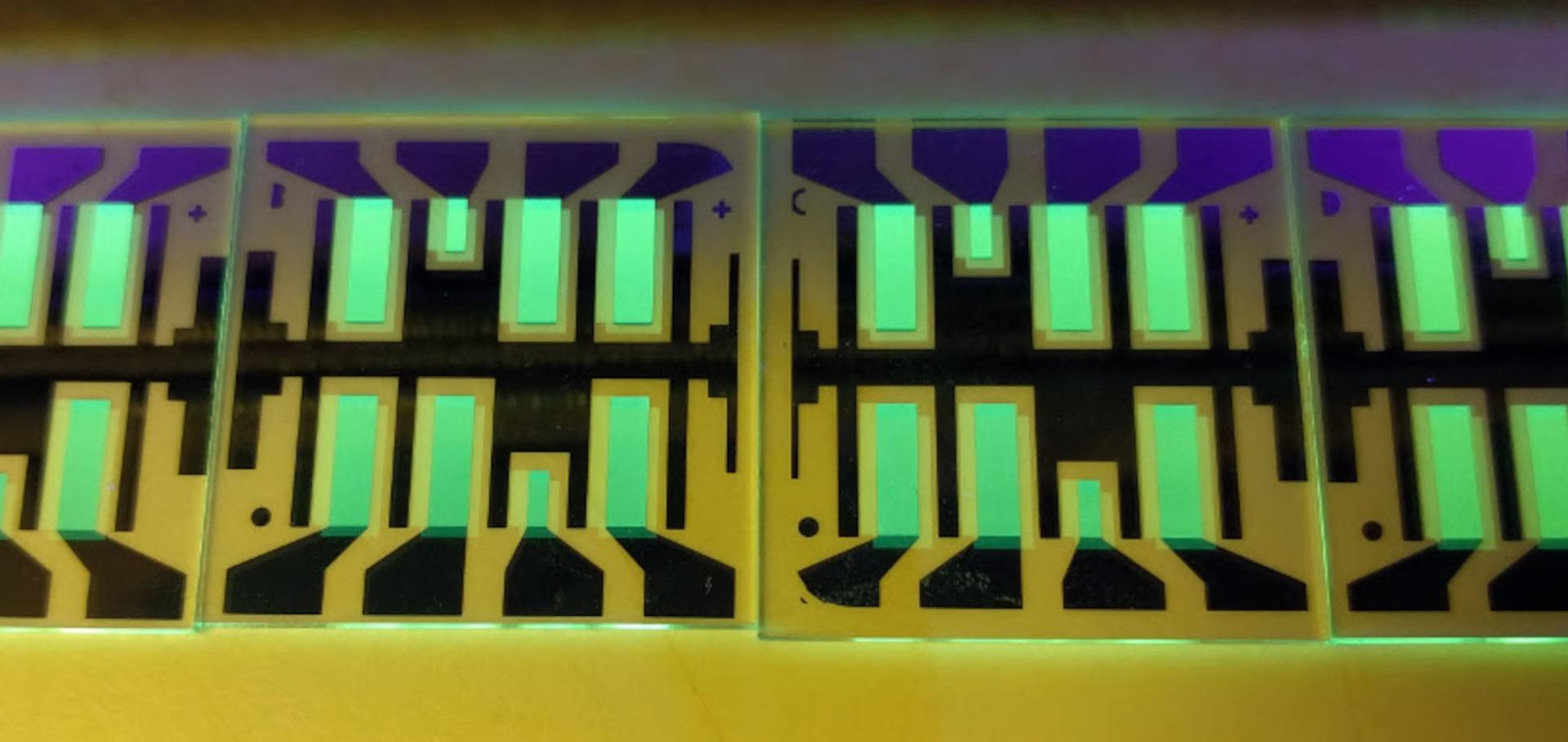Surface engineering using Kumada catalyst-transfer polycondensation (KCTP): preparation and structuring of poly(3-hexylthiophene)-based graft copolymer brushes.
J Am Chem Soc 131:1 (2009) 153-161
Abstract:
Poly(4-vinylpyridine)-block-poly(4-iodo-styrene), P4VP-b-PS(I), block copolymers obtained by iodination of readily available P4VP-b-PS block copolymers strongly adhere to variety of polar substrates including Si wafers, glasses, or metal oxide surfaces by a polar P4VP block, forming polymer brushes of moderately stretched PS(I) chains. Kumada catalyst-transfer polycondensation (KCTP) from the P4VP-b-PS(I) brushes results into planar brushes of the graft copolymer in which relatively short ( approximately 10 nm) poly(3-hexylthiophene), P3HT, grafts emanate from the surface-tethered PS(I) chains. Grafting of the P3HT leads to significant stretching of the PS(I) backbone as a result of increased excluded volume interactions. Specific adsorption of the P4VP block to polar surfaces was utilized in this work to pattern the P4VP(25)-b-PS(I)(350) brush. The microscopically structured P4VP(25)-b-PS(I)(350) brush was converted into the respectively patterned P4VP-PS(I)-g-P3HT one using KCTP. We also demonstrated that KCTP from functional block copolymers is an attractive option for nanostructuring with polymer brushes. P4VP(75)-b-PS(I)(313) micelles obtained in selective solvent for the PS(I) block form a quasi-ordered hexagonal array on Si wafer. The P4VP(75)-b-PS(I)(313) monolayer preserves the characteristic quasi-regular arrangement of the micelles even after extensive rinsing with various solvents. Although the grafting of P3HT from the nanopatterned P4VP(75)-b-PS(I)(313) brush destroys the initial order, the particulate morphology in the resulting film is preserved. We believe that the developed method to structured brushes of conductive polymers can be further exploited in novel stimuli-responsive materials, optoectronic devices, and sensors.Improved bulk heterojunction organic solar cells employing C70 fullerenes
Applied Physics Letters 94:22 (2009)
Abstract:
We show that the fullerene C70 is suitable to replace fullerene C60, which is commonly used as electron transporter and acceptor in small-molecule organic solar cells. It is shown that the higher absorption of C70 leads to high external quantum efficiencies of over 50% in the spectral range of 500-700 nm. By optimizing the energy level alignment to hole transport layers, the absorption, and the ratio of C70:zinc phthalocyanine (ZnPc) in a bulk heterojunction solar cell, an efficiency of =2.87% is achieved. This is a substantial improvement over an identical solar cell employing C60 having =2.27%. The efficiency increase is due to a higher photocurrent, while fill factor and open-circuit voltage for C70 and C60 -containing organic solar cells remain comparable. © 2009 American Institute of Physics.Thick C60:ZnPc bulk heterojunction solar cells with improved performance by film deposition on heated substrates
Applied Physics Letters 94:25 (2009)
Abstract:
We study the influence of different substrate temperatures during the deposition of the ZnPc: C blend layer in bulk heterojunction organic solar cells. It is shown that substrate heating during evaporation leads to a significant improvement in the solar cell performance mainly due to an increase in photocurrent and fill factor (FF). This is attributed to improved morphology resulting in better charge carrier percolation pathways within the ZnPc: C blend, leading to reduced transport losses. Using this method, blend layer thicknesses of 150 nm are possible without loss in FF, which requires a three-dimensional interpenetrating network without isolated clusters. When heating the substrate up to 110 °C, an efficiency of 2.56% is achieved compared to 1.59% for an identical device prepared at room temperature. © 2009 American Institute of Physics.Light trapping in organic solar cells
Physica Status Solidi (A) Applications and Materials Science 205:12 (2008) 2862-2874
Abstract:
One key problem in optimizing organic solar cells is to maximize the absorption of incident light and to keep the charge carrier transport paths as short as possible in order to minimize recombination losses during the charge carrier extraction. The large versatility of organic semiconductors and compositions requires specific optimization of each system. Due to the small thickness of the functional layers in the order of several ten nanometres, coherent optics has to be considered and therefore interference effects play a dominant role. Here we present and discuss concepts for light trapping in organic solar cells. These are wide gap layers in planar solar cells, folded solar cell architectures benefiting from the illumination under inclined incident angles and multiple reflections and absorptions as well as diffraction gratings embossed into the photoactive layer. © 2008 WILEY-VCH Verlag GmbH & Co. KGaA.High throughput testing platform for organic solar cells
Progress in Photovoltaics: Research and Applications 16:7 (2008) 561-576


